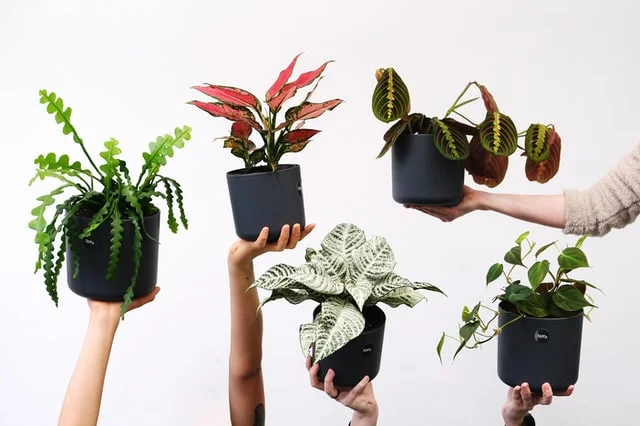Can Philodendrons Grow In An Aquarium? Philodendrons cannot grow completely submerged in an aquarium, but they may contribute to the ecology if their roots are allowed to grow in the water. While philodendrons are poisonous, their toxicity will not have an effect on your fish as long as the leaves are kept out of the aquarium.
The philodendron is a fascinating plant that, if cared for properly, may be used to create an aquarium that you and your fish will enjoy.
Read More: Philodendron Hederaceum Care – A Complete Guide
Table of Contents
Aqua-Philodendrons
The term “Philodendrons” does not relate to a single plant in the traditional sense. Given that there are over four hundred and fifty different kinds of philodendrons, claiming that all philodendrons like to spend their lives immersed in water is just not accurate.
The Velvet-Leaf Vine Philodendron (Philodendron cordatum) and the Heart-Leaf Philodendron (Philodendron cordatum) are the two finest philodendron species for water systems (Philodendron micans).
The velvet-leaf vine philodendron and the heart-leaf philodendron are both very similar, with just a few significant distinctions between them. The most significant distinction between these two is their look and growth style.
The velvet-leaf vine philodendron will often spread out horizontally, but the heart-leaf philodendron would typically grow up straight. Also, the leaves of heart-leaf philodendron are a lighter, brighter green, while the leaves of velvet-leaf vines have a velvety feel and a more evergreen hue.
Regardless of the kind you choose, both the velvet-leaf vine and the heart-leaf philodendron are among the most straightforward houseplants to care for. If you want to devote the majority of your time and attention to caring for your fish, any of these would be excellent choices for aquarium plants.
Read More: Pothos vs. Philodendron: How to Tell the Difference
Water and philodendrons
Which is better, freshwater or saltwater?
Before purchasing a philodendron for your aquarium, it is crucial to consider the kind of aquarium you have. Is it intended for use with freshwater or saltwater fish? Plants, like most fish, have preferences when it comes to the kind of water in which they will live, and philodendrons are no different.
Some varieties of philodendron are saltwater resistant, but for the most part, heart-leaf and velvet-leaf vine philodendron plants should be kept as far away from saltwater as possible, especially in containers.
The accumulation of salt from tap water causes the leaves of heart-leaf philodendrons to burn (i.e., start crisping up and becoming brown at the edges) when they are cultivated in soil. Philodendron vines, such as the heart-leaf and velvet-leaf varieties, do not thrive in saltwater. Placing them in a saltwater tank is an effective approach to swiftly eliminate them.
The split-leaf philodendron is the only species of philodendron that has been shown to be saltwater tolerant (which is actually a monstera plant, not philodendron). In the event that you have your heart set on include one of the philodendrons in your saltwater aquarium, the split-leaf philodendron is the only one that will really live, even if it is not as aesthetically pleasing as the heart-leaf or velvet-leaf vines.
Read More: Split Leaf Philodendron Care – A Complete Guide
Immersed entirely?
No, philodendrons are unable to and will not survive being completely submerged in water. To expect things to go as planned, you can’t just drop that sucker in the tank.
Philodendrons, on the other hand, thrive when their roots are buried in water, as long as the leaves and vines are allowed to breathe in the fresh air. Because of the way their roots extend in the water, philodendrons will come to life, providing a stunning aesthetic display as well as a tasty treat for your fish to chew on. Despite the fact that it works so well, even those who do not have aquariums would often plant their philodendron in little glass jars filled with water.
Because they are plants, philodendrons need nitrogen to thrive. For you, this means that if you install philodendrons in your tank, they will not only look beautiful, but they will also assist your fish in clearing up nitrogen-based pollutants from their environment. They will remove poisons like as nitrite, nitrate, and ammonia from the environment.
It is true that they do not remove the poisons that underwater plants do, such as high CO2 concentrations, but you can simply purchase some underwater plants to combine with the philodendron to ensure that you have covered all of your bases. When your plants and fish work together, you can create a pleasant and healthy aquarium environment for everyone to enjoy.
Read More: Philodendron Monstera Care – A Complete Guide
Toxicity
Natural Selection
There are a lot of myths out there regarding the dangers of putting philodendrons and pothos in your aquarium, and many of them are false.
One YouTube video states that a “Pothos DESTROYED my aquarium!” while, in reality, the pothos that they put simply helped to eliminate the black algae in their aquarium, according to the video (and all the fish were totally fine).
Bringing philodendrons and pothos into a new environment may result in their overtaking other plant species. Naturally occurring competition operates in this manner, which is unfortunate. Survival of the fittest is the only rule. Furthermore, since philodendron are so effective at draining nutrients from the water, they may make it more difficult for other plant species to thrive.
With fish, on the other hand, this has never been an issue. Just be sure to keep an eye on your tank’s plant life once you’ve added a philodendron.
Read More: Can Philodendron Be Grown In Water?
Leaves Containing Toxins
Sadly, the myth that philodendron is poisonous is true. At the very least, philodendrons are poisonous to some degree. Their roots are non-toxic, and placing them in an aquarium with a multitude of colorful fish will have no negative effect on them.
Their leaves, on the other hand, contain oxalic acid, which is hazardous to both people and animals. The leaves can get into the aquarium water, which is why it’s so important to keep them out.
This will not only cause the other plants to perish, but if the fish start nibbling on the leaves, they will succumb to the same fate.
If you do decide to add a philodendron to your aquarium, keep an eye out for your roaming house pets while doing so (especially cats and dogs). Maintain a safe distance between the aquarium and the ground so that an inquisitive cat or nosy dog cannot reach the foliage and take a bite of the plants’ leaves.
It is possible that philodendron leaves may induce swelling in the mouth, tongue, and throat if consumed by people or animals (which makes it kind of hard to breathe). In severe situations, it may also result in vomiting and diarrhea, among other symptoms.
How To Plant A Philodendron In A Fish Tank Correctly
Proper philodendron aquarium planting procedures are as follows:
- A Philodendron cutting must be prepared before it can be placed in the water to ensure it grows well. New roots are sprouting from this incision.
- The water should be at least an inch below the lip of the container, jar, or fish tank. Allow the chlorine (if any) to evaporate throughout the course of the night.
- You may use gardening clippers or scissors to cut a six-inch piece of Philodendron plant stem. Remove the stem just below the leaves.
- At a few different leaf nodes on the bare stems, remove around three sets of leaves at a time. Immerse the cuttings’ leafless ends in water.
- The tops of the leaves should be above the surface of the water. Additionally, the bare nodes must be immersed in water.
- In around ten days, you’ll start to see roots if you keep changing the water every three days (not overnight).
Conclusions
Can Philodendrons Grow In An Aquarium?
It’s time to make your pick now that I’ve probably covered all you need to know about Philodendron! Because it acts as a natural filter for water, the plant may be very successful at keeping pollutants associated with nitrogen out of the water.
Although this plant does not absorb as much carbon dioxide as other plants, you may always combine it with other species to achieve equilibrium. If you don’t follow the directions carefully, you might do a lot of damage to your Philodendron. Let’s hope your fish tank turns out just the way you envisioned it!
Photo by Severin Candrian on Unsplash



